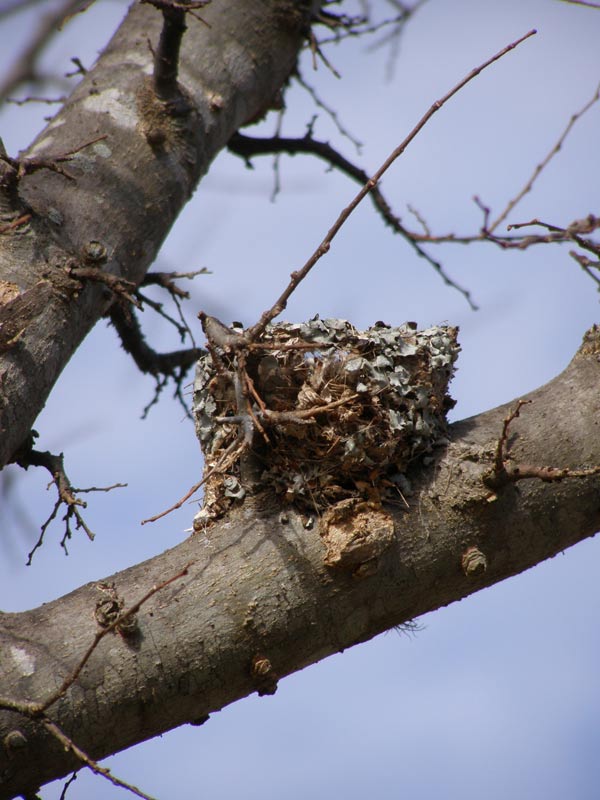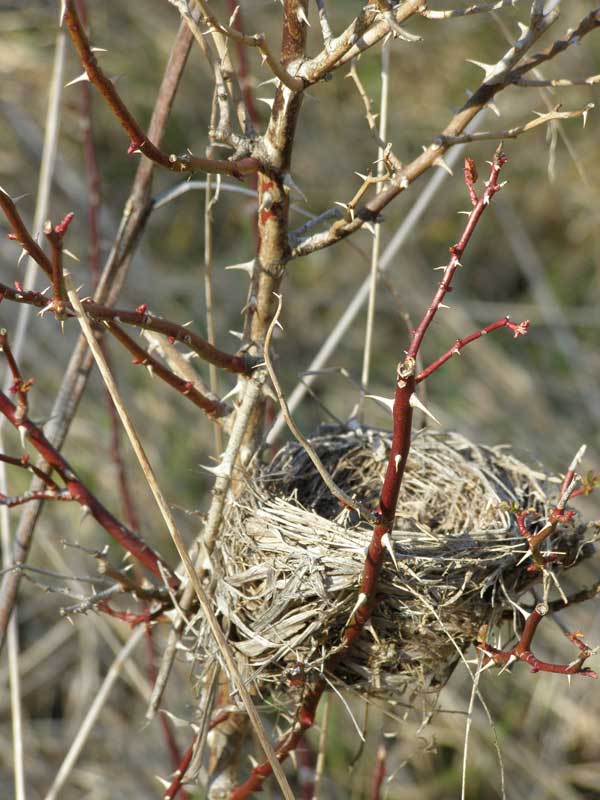
Signs of spring and birds’ nests

Sturdily built nest of a clever bird architect. Photo by Ken Moore
By Ken Moore
Flora Columnist
The familiar signs of spring for most of us are already evident. Crocuses and Japanese Apricot, Prunus Mume, are in flower and daffodils are showing flower buds. But these are foreigners, long ago established in our cultivated gardens. True signs of spring are the deepening stem colors and swelling flower and leaf buds in the wilds of nature’s garden. This past weekend, four of us enjoyed discovering some of these spring signals along Bolin Creek trails in the university’s Carolina North Preserve (Horace Williams Tract).
Following are descriptions of some early-spring signals. But first I must digress to share what we saw while crossing a field. We spied a really beautiful tiny lichen-encrusted bird nest situated about ten feet above us on a lateral limb of a small Hackberry tree, Celtis laevigata. We thought the architect to be a hummingbird. The nest appeared so sturdy we could imagine it being used a second season. We’ll return in late spring to investigate. What a clever bird to site the nest in this particular Hackberry: the trunk and lower limbs are abnormal with numerous thorny, twisted twig growths emerging from the characteristic warty bark. It presents a very unappealing climb for predators.
In the tall grass beneath the tree, we discovered another small nest, this one of grass and moss, only two feet above the ground. It was neatly constructed in a thorny Carolina Rose, Rosa carolina, another site rather uninviting for potential predators. Perhaps one of the smaller sparrow species was responsible for this nest. Hopefully, the accompanying photographs are enough for proper identification of either or both by a Citizen reader.
The lower nest drew our attention to the burgundy color of the rose stems securing it. Sure signs of spring are the deepening colors of the previous year’s stem growth on many species of trees and shrubs. Like the Carolina rose, Sourwood, Oxydendron arboreum, and Silky Dogwood, Cornus amomum, turn burgundy red. The yellow green stems of streamside willows are easy to spot at long distances. The polished yellow-green branch tips of the common sweetgum, Liquidambar styraciflua, are subtler, but well worth a closer look. On your walks, be alert for other tree and shrub stem colors during these late-winter weeks.
Swollen buds are another sign of approaching spring. We observed that the tiny round flower buds of spicebush, Lindera benzoin, are quite swollen, a prelude to clusters of little yellow flowers that cast a yellow glow across floodplain forests in March before leaves emerge. More noticeable are the swelling red buds of Red Maple, Acer rubrum. The effect will be spectacular in mid-February when those maple flowers are viewed against the blue sky.
If you don’t already regularly enjoy outdoor walks, begin them now during this warm spell to see how many other signs of spring you can find. Don’t let the cold weather that will surely return keep you inside. Even in bitter cold, you will discover that these true signs of spring are hardily persistent.
Email Ken Moore at flora@carrborocitizen.com. Find previous Ken Moore Citizen columns at The Annotated Flora (carrborocitizen.com/flora).

from → Ken Moore's Flora, Winter

Comments are closed.